Machrihanish Golf Club
Argyll, Scotland

The enduring appeal of Machrihanish is captured in this southwest view from the inward nine across the fifth green to the Irish Sea.
My brother John commenced the 1999 Machrihanish profile as follows: ‘Fun. That is a telling adjective when applied to a course, yet how many times do we hear it used? Too many architects and owners remain preoccupied with building a ‘championship course’ with ‘eighteen signature holes.’ Instead, everyone should remember the fundamental principle of golf: enjoyment. Why not emphasize what Alister MacKenzie somewhat suggestively referred to as ‘pleasurable excitement’? Such courses are the ones that remain closest to players’ hearts. Rarely do you hear a player enthusiastically discussing what his rounds at Doral have meant to him. No, it is courses such as Cypress Point, Jasper Park, Royal West Norfolk, and Cruden Bay that stir such emotions. Machrihanish is another such romantic course.’
Very few writers used words like ‘fun’ and ‘romantic’ twenty years ago to describe a course. That has certainly changed and GolfClubAtlas played a role in identifying design factors that truly matter. Length has never been a prized criterion in our writings other than as a barometer for requiring the golfer to hit variety of approach shots. At 6,226 yards from the back, length is about the only thing that Machrihanish doesn’t possess. Everything else, it has in spades: splendid isolation, rumpled fairways, varied green sites and some of the best interior green contours found on any course. Throw in the wind and the golfer is guaranteed a rambunctious time.
Charles Hunter, of Prestwick fame, played a role in expanding the original ten holes to twelve holes and it was Old Tom Morris that first fashioned eighteen holes here. Several other architects have had a hand in the course’s evolution, most notably J.H. Taylor and then Sir Guy Campbell after World War II. The common denominator between all four men is that heavy earth moving equipment has never been allowed to mar the landscape. Unlike plenty of links, the greens don’t play second fiddle to the rollicking fairways. Far from it – these greens are collectively some of the most imaginative and distinctive to be found and lend the design a sophistication that has attracted devotees around the globe.
The routing is the quintessential out-and-back, with enough changes of direction to keep the golfer off balance. The front is the more famous – and dramatic. Old Tom Morris’s brilliant first tee placement high over the beach creates one of the indelible diagonal carries in the game. The approach to the elevated second green is the most stern on the course and the third tee ball transports the golfer into the scintillating dunes that stay with the golfer for the rest of the outward nine. While it really is the stuff of dreams, here’s the catch: the most memorable golf shots may actually fall on the inward nine. Starting with the approach to Sir Guy Campbell’s one shot eleventh, the golfer faces a series of vexing shots into greens through the sixteenth.
Add the raw beauty of the front with the excellent golf qualities found on the back and Machrihanish ticks all the boxes for what turns a course into a siren, wooing golfers from points afar. One thing to note before we go on a tour: the professional shop. Though the building is not architecturally meritorious, it does occupy a sensational location hard by the first tee. The trolleys are but yards from the tee and the ability to get a warm welcome from Head Professional Jennie Dunn and then moments later, be standing on the first tee, is one of the cleanest getaways in the sport.
Holes to Note
First hole, 425 yards, Battery; With the heroic drive over the beach, the first at Machrihanish arguably possesses the finest opening tee shot in golf. Because the second shot is relatively flat, some golfers quibble that it might not be the best opening hole, full stop. Whatever! Many clubs in the British Isles play the beach as out of bounds so as to ensure that the difference in the tide does not play a key (and lucky) role in determining the outcome of a stroke play competition. However, Machrihanish has wisely left the beach as a lateral water hazard, thereby relaxing the players on the tee and tempting them to be more bold with their tee shots as being on the beach is no worse than being in one of the right fairway bunkers.

Early morning bliss on the first tee. Just how much of the beach should you carry? It’s a timeless question that dates back to Old Tom Morris’s work here in 1879.
Second hole, 395 yards, Machrihanish; The golfer needs to be cognizant of the Machrihanish Burn that bisects the fairway some 250 yards from the tee. Getting close – but not too close – to it makes the demanding uphill approach more manageable. The green is a modified punchbowl with a pronounced valley running through the spine of the green and the player’s first thought is that he has never seen anything like it before. His second thought is often times,‘Why not?’ At first there might not appear to be enough hole locations, but the left side is more usable than one might think. The second must have started life as a par 5 in the pre-1900 days of the gutta percha ball. With the arrival of Haskell, the second became a brute of a two shotter with hickory clubs, though its gathering green makes the proposition doable.

The Machrihanish Burn is in the foreground , followed by the directional marker high on the hill and the yellow flag visible to the right.
Third hole, 375 yards, Islay; After the blind tee shot across the rear of the sixteenth green, a most appealing hole unfolds. With the Irish Sea visible beyond and the wonderfully old-fashioned sunken green set at a slight angle to the fairway with the revetted bunkers dug into the hills near the green, this hole is visually appealing from both the natural perspective and the architectural one – it is a well-designed hole in a beautiful setting. In relatively calm conditions, it is not that difficult and offers a birdie opportunity for the player who uses the ground well to get his approach close. A drive down the right is always ideal, as the player is rewarded with a straightforward pitch down length of the deep green. Still, a golfer out of position down the left can use the bank right of the green to bounce his ball left toward certain hole locations. This ‘inclusive’ architecture is of the highest order: the good player can seek a definite advantage while the rest of us still have fun and can even score well if we keep our wits about us. Gathering greens don’t function well on clay sites but when given sandy soil, it’s wonderful to see the architect take advantage.

Just think about the first three green locations: the first as an extension of the fairway, the second well elevated played to a blind putting surface and now the third, sunken low in its own bowl. Talk about variety – what more could any golfer hope to experience?!
Fourth hole, 130 yards, Jura; The better the landscape, the less the architect needs to muddle with things. At least that’s what we hope and that is indeed what we find at Machrihanish. The one shot fourth is simplicity itself: tees on one dune, shallow valley, green on another dune. None of the architects have felt the need to junk it up with man-made features. A solo front left bunker provides menace but to go long and have to recover to a green that runs away might prove even more problematic.

The golfer’s connection with nature feels both strong and genuine thanks to the no muss, no fuss architecture.
Fifth hole, 390 yards, Punch Bowl; The authors’ favorite hole. From the tee the player has the choice of banging a driver toward the narrow neck of the fairway as it swings left or lay back with a fairway wood to the wider section of the fairway. While the daunting prospect from the tee would seem to make the decision an easy one, the knowledge of the approach shot’s difficulty nevertheless tempts the player to seek that distant twenty-yard stretch of fairway with the driver. The long, narrow, sloping green is much easier to find with a 9-iron than with a 6-iron. This hole can wreck a card in stroke play and is a terrific match play hole.

The golfer is well and truly into prime linksland by the middle of the outward nine, as captured by this view down the 5th fairway.

As seen from behind, the 5th green is one of five greens at Machrihanish to feature a severe slope in the front before falling away toward the rear.
Seventh hole, 430 yards, Bruach More; A course’s routing does much to define its lasting appeal. Yet, the term ‘routing’ is a misunderstood one. For instance, Machrihanish is an out-and-back routing but there is more to it than that. Routing also encapsulates how the architect captures natural features within the playing corridors. In this aspect, Machrihanish positively shines. Some fairways like the first and eighth are set at an angle to the tee, others like the fifth and fourteenth feature humpy-bumpy random undulations. Here at the seventh, the tallest dune on the hole falls some 300 yards from the tee and obscures the green from the fairway. It is just another obstacle with which the golfer must contend. Ultimately, the golfer starts to recognize the diverse manner in which the holes fall across the landscape and an appreciation dawns on just how many questions Machrihanish poses of the player.
Eighth hole, 340 yards, Gigha; A wonderfully natural hole where all that was needed was to have a tee flattened, a fairway mown and a hill leveled for a green. The fairway is generous for a hole of this length, but the approach is most precise. If the shot goes long, the player faces a fifty-yard pitch back up the hill, while an approach that is just short will likely roll back thirty yards toward the player. Familiarity makes the hole seem harder the more you play it.
Twelfth hole, 510 yards, Long Hole; Proof that a good green complex can save a three-shotter from two straightforward first shots. The raised green was beautifully placed at an angle to the fairway and runs sharply away, requiring the player to think a good deal about where he wants to position his second shot. Also, the bunkers and dip in front of the green force the long player either to be sure he can get home in two or to lay up as there is nothing but trouble for being in the no-man’s land short of the green. The openness at the rear of the green encourages attacking play (an attribute that Alister MacKenzie fully endorsed) and lets the golfer putt back up the hill.
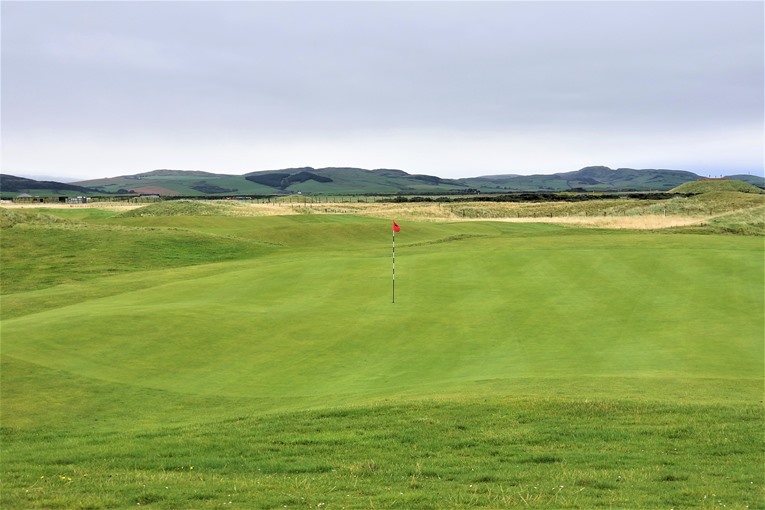
As seen from behind, the 12th putting surface cascades from front to back and features over a four foot drop. An approach just four feet past today’s hole location catches the funnel and is sweep off the green.
Thirteenth hole, 365 yards, Kilkivan; The key is the putting green with its abrupt three foot rise at the front followed by its front to back pitch. To get the approach shot close when the hole is on the front just beyond the rise, requires skill and imagination. It is simply not a shot that many people are accustomed to facing – and that is precisely why the shot possesses great appeal. Put another way, a green that slopes from back to front and is prosaically bunkered left and right rarely challenges the golfer to invent a shot.
Fourteenth hole, 435 yards, Castlehill; Royal Dornoch is cherished in part because its holes that are removed from the sea are among its best. Same for Machrihanish. A hole like fourteen isn’t nearly as glamorous as the first but its playing qualities are every bit the equal.
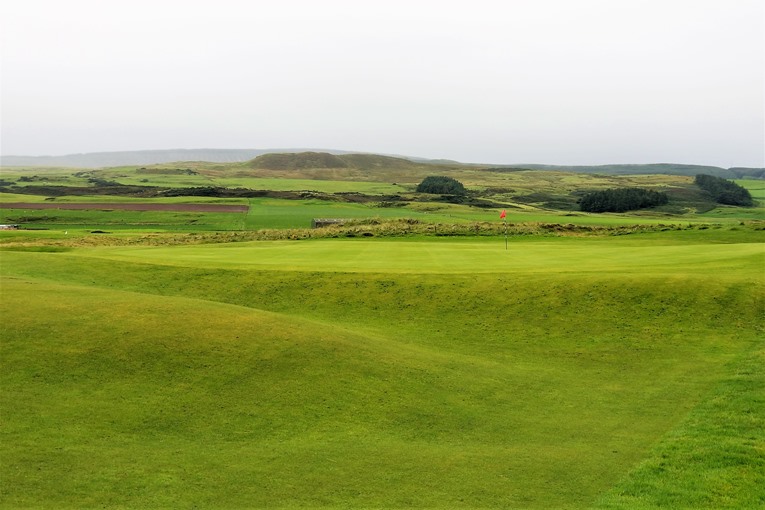
Imagine all the possible iterations. On a still day, the golfer can fly the ball directly onto the putting surface and save himself a headache. In any kind of wind – against, following or cross – and a slew of other options need to be weighed by the player.
Fifteenth hole, 165 yards, The Hut; A fetching short hole that is probably a Morris original. Players can easily volley from one side of the table top green to the next and back again. Once you have seen it done, you begin to appreciate that this may be the day’s single most exacting shot.

As seen from the left, it is anything but! The hole becomes harder with time as you witness a variety of debacles befall the golfer.
Sixteenth hole, 230 yards, Rorke’s Drift; Holes fourteen and sixteen guarantee that the golfer will hit a wide range of clubs into the greens coming home. This is the final putting surface that slides from front to back and given the hole’s length, the focus is admirably placed on the ground game. The sixteenth isn’t particularly photogenic but it is good, stout golf.
Some sniff at the two hole finish, complaining that neither hole fits the rest of the course. While the two holes do indeed play out of the dunes and feature fairways on the one relatively flat portion of the property away from the sea, each hole has merits. First, out-of-bounds is starkly tight down the left of both holes. Second, one of the best gathering bunkers on the course is found greenside at the penultimate hole. For those that play safely down the right (i.e. away from the out of bounds), this right greenside bunker poses a real problem. Third, the pushed up Home green features an attractive bank along the right and rear and right hole locations work wonderfully in tandem with the out-of-bounds to create interesting playing angles down a straight playing corridor.

As seen from the right side, today’s hole location on the Home green was back left and the needed up and down was anything but simple.
Absent a brisk breeze, Machrihanish is not too difficult a course, given it measures 6,226 yards from the back markers. In contrast to links like Muirfield, Carnoustie and Royal Lytham & St. Annes, bunkers neither proliferate nor do they define the playing strategy of the vast majority of the holes. Instead, the landforms and the imaginative and varied ways in which the holes hit them are what make the course special. Combined with the wind and its convoluted greens, the ground game takes center stage. In that regard, the course very much harkens back to a time when the sport was a simpler affair. Yet, that is precisely what people yearn for today and it helps explain why the course acts as a magnet for golfers.
Overall, the mix of bruising holes (e.g. the first, seventh, fourteenth, sixteenth) is nicely counterbalanced with 1/2 par birdie holes that the player thinks he can take (e.g. the third, sixth, ninth and eighteenth) to the point where the golfer never gets discouraged. The testiest shots are spread throughout the round and the golfer must properly execute a handful of key shots to score to his handicap. Otherwise, the golfer feels he might be able to ‘take’ the course. This rarely happens, but it is this feeling of hope coupled with the sheer exhilaration of playing here that draws golfers back decade after decade. Plenty of over-the-top modern designs end up being a ‘one and done’ events whereby the golfer is pleased to tick a famous course off his list but has no real desire to ever return; Machrihanish is altogether on a far higher design plain.
To conclude, let’s again revisit my brother’s words from twenty years ago: ‘Machrihanish is one of few courses in the world that would have the player, after playing 54 holes in one day, checking his watch against the setting sun to see if there is still time for a few more. Is there any greater compliment to be paid to a course?’ How true and it helps to explain why my brother has been an overseas member there since 1998.
The End





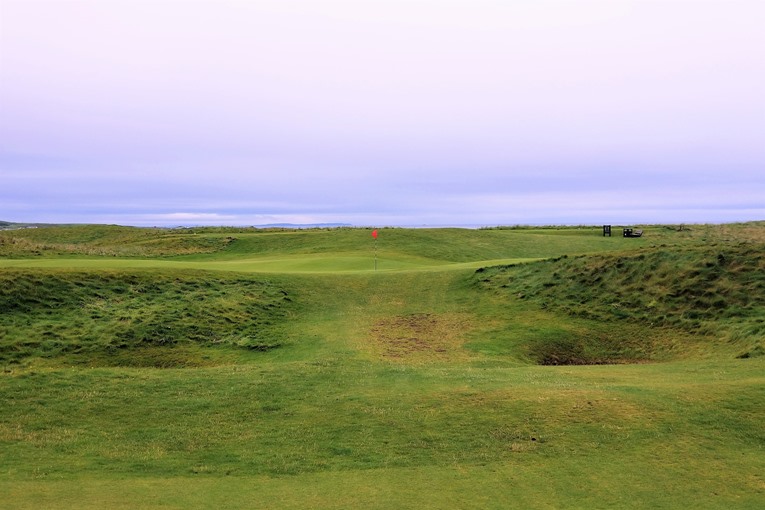
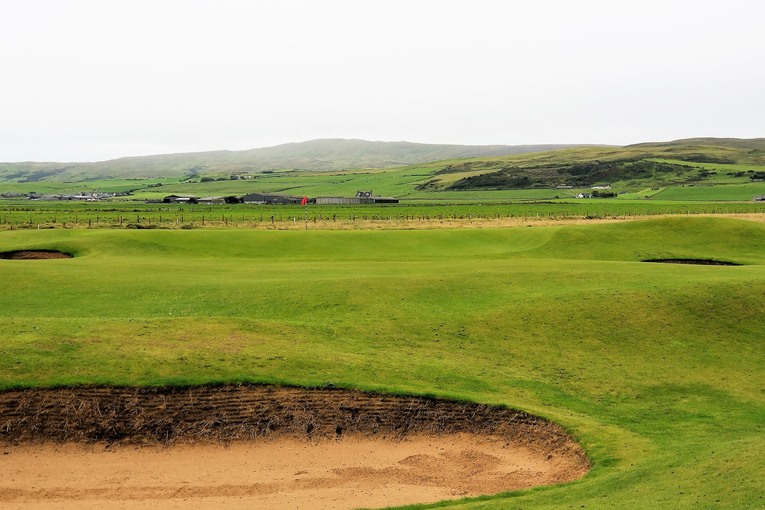
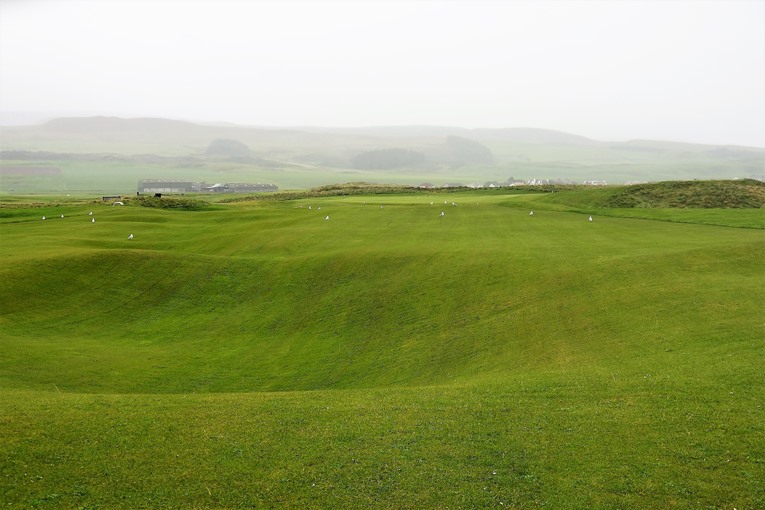





![Cabot Highlands (Castle Stuart) [2016]](https://golfclubatlas.com/wp-content/uploads/2008/12/Castle-Stuart-Golf-Links-500x383.jpg)


